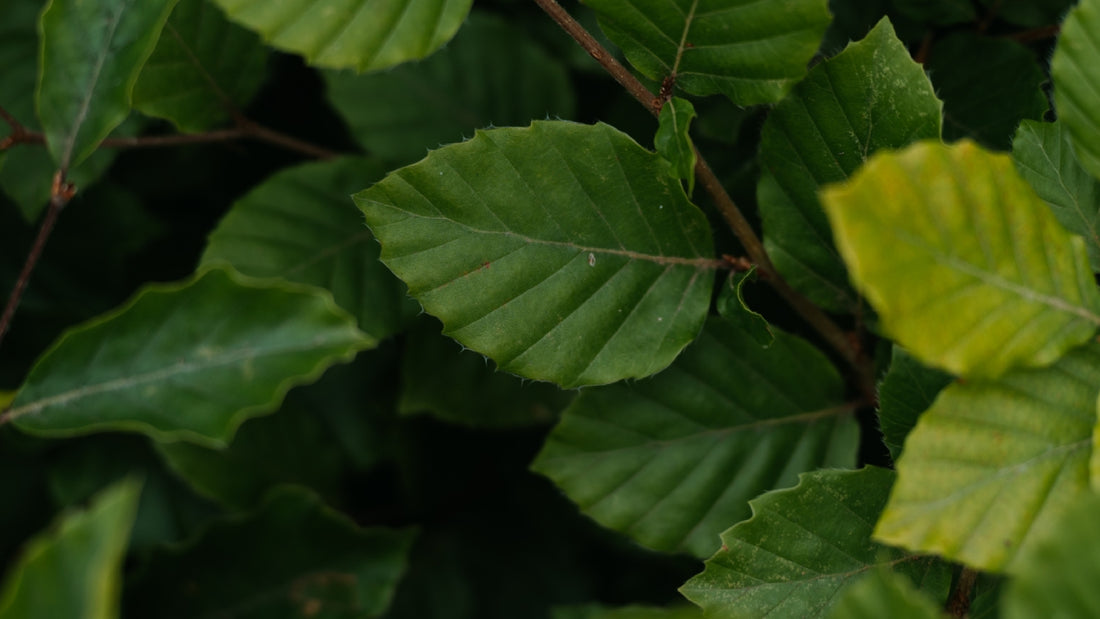
Common Beech the Queen of British Trees
Share
Common beech, also known as Fagus sylvatica, is a monumental and majestic tree, often referred to as the queen of British trees. This enchanting species is home to rare wildlife and its cathedral-like branches create a breath-taking canopy that inspires awe among those who wander beneath it. Known for its smooth grey bark, distinctive leaf buds, and prickly seed cases, the common beech is a vital part of the European landscape and ecology.
The species is used extensively in both Forestry and landscaping as a Beech hedge. This article will talk about Beech as a forestry tree.
Beech trees: Appearance and Characteristics
Height and Canopy: Mature beech trees can reach heights exceeding 40 meters, developing a broad, domed crown that provides a dense canopy. The smooth, thin grey bark often features slight horizontal etchings, adding to its distinctive appearance.
Leaves: Young leaves are lime green and covered in silky hairs, which they lose as they mature and darken to a deeper green. The leaves are 4-9 cm long, oval, and pointed with a wavy, hairy edge.
Flowers: The beech tree is monoecious, meaning it bears both male and female flowers. In April and May, male catkins hang from long stalks at the ends of twigs, while female flowers grow in pairs surrounded by a cup.
Fruits: The fruit of the beech tree, known as beechmast, is encased in woody, prickly seed cases. These triangular nuts are released in autumn, providing a valuable food source for wildlife.
Winter Identification: In winter, beech trees are identifiable by their sharply pointed leaf buds that are not pressed against the twigs. The trees often retain their leaves throughout the winter, a phenomenon known as marcescence.
Habitat and Distribution
The natural range of the common beech extends across Europe, from southern Sweden to northern Sicily, thriving in humid atmospheres and well-drained soils. In the UK, beech is native to south-east England and south-east Wales, typically found in woods or as solitary trees on drier, free-draining soils such as chalk, limestone, and light loams.
Ecological Importance of Beech trees
Beech woodlands are characterized by their dense canopy and thick layer of leaf litter, which supports a variety of specialist shade-tolerant plants and fungi. The dense canopy also provides an important habitat for many butterflies, particularly in open glades and along woodland rides.
Wildlife Habitat: Beech foliage is consumed by caterpillars of several moth species, and its seeds are eaten by mice, voles, squirrels, and birds. Native truffle fungi thrive in beech woods, forming symbiotic relationships with the trees. Beech trees, especially older specimens, offer habitats for deadwood specialists like hole-nesting birds and wood-boring insects.
Conservation Concerns: Beech faces threats from root rot caused by fungal pathogens and beech bark disease, which can be fatal. Additionally, they are vulnerable to bark stripping by grey squirrels, which can severely damage young trees.
Cultural and Historical Significance
Beech holds a significant place in mythology and tradition. Associated with femininity and known as the queen of British trees, the beech was revered in Celtic mythology. Beech twigs were traditionally used for divining, and the tree’s leaves were once boiled to make poultices for swelling.
Uses of Beech
Beech wood is valued for its fine grain and strength, making it ideal for furniture, tools, and sports equipment. It is also used as firewood and for smoking foods. Historically, beech nuts were fed to pigs and are still sometimes used as a coffee substitute in France. Beech also serves as a popular hedging plant, retaining its leaves to provide year-round cover.
Climate Change and Future Forestry
Beech plays a crucial role in fighting climate change due to their carbon-locking capabilities. However, they are susceptible to damage from grey squirrels and vulnerable to drought, which could impact their future in southern and eastern England. Nonetheless, their ability to grow well under shade makes them suitable for sustainable forest management practices that avoid clear-cutting.
Identifying Beech Trees
When identifying beech trees, look for their smooth grey bark, pointed oval leaves with hairy edges, and shiny brown twigs with pointed orange buds. In autumn, beech trees can be recognized by their dense canopy of yellow and bronze leaves and the triangular seeds released from prickly husks.
Fun Facts and Figures
- Beech trees can live for up to 350 years in the wild and can grow up to 45 meters tall.
- The tallest native beech tree in the UK, located in Hagg Wood, Derbyshire, was measured at 45 meters in 2018.
- The thickest beech tree in the UK, the Plas Newydd Beech on Anglesey, has a trunk circumference of 10 meters.
- Beech wood was commonly used for writing tablets before paper was invented, and the Old English word for beech, 'boc', is the origin of the modern word 'book'.
Conclusion
The common beech (Fagus sylvatica) is an integral part of the European landscape, valued for its ecological, cultural, and practical contributions. From providing habitats for rare wildlife and supporting biodiversity to its historical and modern uses in woodworking and food production, the beech tree remains a vital and cherished species. Despite facing threats from disease, pests, and climate change, the beech tree’s resilience and adaptability ensure its continued importance in our natural and cultural heritage.



